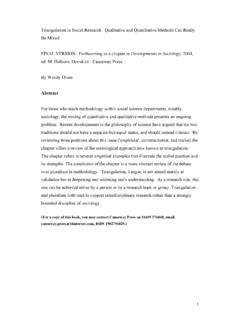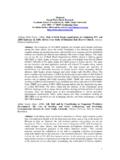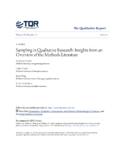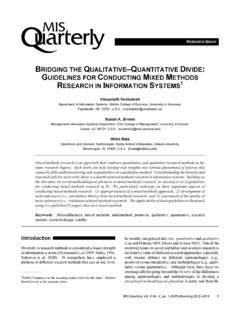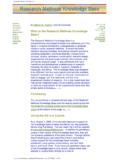Transcription of Issues in Mixed Methods Research
1 1 Issues in Mixing Qualitative and Quantitative Approaches to Research Pat Bazeley Research Support P/L, Bowral, Australia Presented at: 1st International Conference - Qualitative Research in Marketing and Management University of Economics and Business Administration, Vienna 10th April, 2002 Published in: R. Buber, J. Gadner, & L. Richards (eds) (2004) Applying qualitative Methods to marketing management Research . UK: Palgrave Macmillan, pp141-156. Abstract That Mixed Methods studies have become trendy again after a period of disrepute does not mean the Issues such Methods raise have gone away. Definitional, paradigmatic and methodological Issues continue to be raised when researchers write about Mixed Methods , while design Issues , Issues in sampling, analysis and reporting and wide-ranging demands on researcher skills, finances and time are faced daily by those involved in a Mixed Methods study.
2 Mixed Methods researchers, in bringing together the benefits of both qualitative and quantitative approaches to Research , often claim greater validity of results as a reason for their methodological choices, but without adequate consideration of the Issues involved such validity may be more imagined than real. Keywords Mixed Methods ; quantitative; qualitative; methodology 2 Introduction After a period in the paradigmatic wilderness, Mixed Methods Research has regained not just acceptability, but popularity, with a significant number of studies arguing its virtues in terms of greater understanding and/or validation of results. But all is not plain sailing working with Mixed Methods raises a range of Issues above and beyond those encountered within a particular methodology.
3 Not the least of these is that there is no one Mixed Methods methodology, and the term can be applied to widely divergent approaches to Research . Defining Mixed Methods Tashakkori and Teddlie (1998) argued that the term Mixed model is more appropriate than Mixed method for Research in which different approaches are applied at any or all of a number of stages through the Research , their point being that mixing often extends beyond just the Methods used in the Research . Indeed, mixing of methodologies within a broad quantitative or qualitative approach may raise almost as many Issues as when working across approaches (Barbour, 1998); mixing may also occur across different disciplinary traditions, for example, in social history, or when scientists engage in social Research to evaluate the impact of their work.
4 It becomes necessary, therefore, to clarify just what is being Mixed and how it is being Mixed . The mixing may be nothing more than a side-by-side or sequential use of different Methods , or it may be that different Methods are being fully integrated in a single analysis (Caracelli & Greene, 1997). Defining qualitative and quantitative When thinking Mixed Methods , most social scientists think in terms of some combination of qualitative and quantitative approaches to Research , and these kinds of combinations will be the focus of this paper. Here too there are definitional problems problems which relate to paradigmatic and other Issues typically associated with mixing Methods . Qualitative and quantitative approaches have been distinguished (and thereby defined) on the basis of the type of data used (textual or numeric; structured or unstructured), the logic employed (inductive or deductive), the type of investigation (exploratory or confirmatory), the method of analysis (interpretive or statistical), the approach to explanation (variance theory or process theory), and for some, on the basis of the presumed underlying paradigm (positivist or interpretive/critical; rationalistic or naturalistic).
5 Perhaps our inability to clearly specify what all of us have a general sense of is indicative of the lack of a clear distinction that what we are talking about is a continuum with a number of independent dimensions along which any particular Research may be placed. If one uses numbers, interpretation is still involved. If one s data are texts, counting may still be appropriate. Variables do not necessarily have clear-cut meanings; processes can be revealed through numeric analysis as well as through narrative, and so on. This inability to definitively distinguish one approach from another has implications for the acceptability of mixing Methods in that lines of conflict cannot be clearly drawn. Because there is no necessary congruence between the different dimensions of the quantitative-qualitative distinction, the terms themselves are most useful either for giving a sense of overall direction in a study (hence my use of the term approaches), or simply as descriptors of the type of data being used (textual or numeric).
6 Even the latter is problematic (suggesting that approach and data type are necessarily linked), but it at least avoids the problems associated with suggesting there are such things as quantitative or qualitative paradigms or methodologies. Paradigms Approaches taken to defining qualitative and quantitative have long been associated with different paradigmatic approaches to Research different assumptions about the nature of knowledge (ontology) and the means of generating it (epistemology). The idea that one s paradigmatic view of the world might be related to the way one went about researching the world was prompted by Kuhn (1963), while Guba and Lincoln s work on naturalistic inquiry ( Lincoln & Guba, 1985) contributed significantly to the paradigm wars of the 80s.
7 Their concerns about the paradigmatic 3 assumptions underlying Research were taken up by many writing about approaches to social Research and social Research methodology in that period. Much of the concern arose as a reaction to the earlier dominance of the positivist world view that privileged objective observation and precise measurement over interpretation of subjective experience and constructed social realities. Researchers holding the belief that there were strong associations between paradigm, methodology and Methods consequently considered different methodologies and Methods to be philosophically incompatible, making their combination logically impossible. During this period, therefore, Mixed Methods Research was strongly attacked and fell from favour amongst methodologists.
8 The positivist approach to social and behavioural science, adopted at the urging of John Stuart Mill and others in order to build respectability among scientists (Guba & Lincoln, 1994), has, Howe and Eisenhardt (1990) have suggested, not only served social science badly, but also has largely been ignored as a basis for natural science. They argue that all scientific observation, analysis and theorising involves acts of interpretation, and all investigation is theory laden. It may be too simplistic to suggest, however, that if all Research is interpretive, there is no problem. Following their review of 56 Mixed Methods studies, Greene, Caracelli and Graham (1989) concluded: Our own thinking to date suggests that the notion of mixing paradigms is problematic for designs with triangulation or complementary purposes, acceptable but still problematic for designs with a development or expansion intent, and actively encouraged for designs with an initiation intent (Greene et al.)
9 , 1989, ). It could be said that paradigmatic Issues raised by Mixed Methods Research remain unresolved. Indeed, one can t Research or prove paradigms, and paradigmatic debates can never be resolved. The early 1990s saw a series of rejoinders to those who had given paradigms so much attention (particularly evident in the Educational Researcher) and a shift in emphasis to the more tractable Issues of design and Methods (Krantz, 1995) and features of the knowledge claims that could be generated (Greene & Caracelli, 1997). Pragmatism increasingly overruled purity (Rossman & Wilson, 1985) as the perceived benefits of mixing Methods in getting Research done came to be seen as outweighing the importance of the philosophical difficulties in their use (Miles and Huberman, 1994).
10 Thus, according to Miles and Huberman (1994, ): The question, then, is not whether the two sorts of data and associated Methods can be linked during study design, but whether it should be done, how it will be done, and for what purposes. Purpose and design Often the purpose for choosing a Mixed Methods design is not made clear by the researcher (Greene et al., 1989), potentially leading to confusion in the design phase of the study. Some studies may not be considered to have employed Mixed Methods at all in so far as they do not give recognition to the full contribution of each method (Patton, 1988). Purposes necessitating Mixed Methods may be corroboration, expansion or initiation (Rossman & Wilson, 1985). Initiation, in the form of an iterative, nested, holistic or transformative design (Caracelli and Greene, 1997), requires an integration of Methods in contrast to the simpler component designs typically used for corroboration or expansion.

